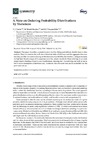Please use this identifier to cite or link to this item:
https://accedacris.ulpgc.es/jspui/handle/10553/42141
| DC Field | Value | Language |
|---|---|---|
| dc.contributor.author | Garcia, V. J. | en_US |
| dc.contributor.author | Martel-Escobar, M. | en_US |
| dc.contributor.author | Vázquez-Polo, F. J. | en_US |
| dc.date.accessioned | 2018-10-15T11:28:15Z | - |
| dc.date.available | 2018-10-15T11:28:15Z | - |
| dc.date.issued | 2018 | en_US |
| dc.identifier.issn | 2073-8994 | en_US |
| dc.identifier.other | WoS | - |
| dc.identifier.uri | https://accedacris.ulpgc.es/handle/10553/42141 | - |
| dc.description.abstract | This paper describes a complementary tool for fitting probabilistic distributions in data analysis. First, we examine the well known bivariate index of skewness and the aggregate skewness function, and then introduce orderings of the skewness of probability distributions. Using an example, we highlight the advantages of this approach and then present results for these orderings in common uniparametric families of continuous distributions, showing that the orderings are well suited to the intuitive conception of skewness and, moreover, that the skewness can be controlled via the parameter values. | en_US |
| dc.language | eng | en_US |
| dc.relation.ispartof | Symmetry | en_US |
| dc.source | Symmetry-Basel [ISSN 2073-8994], v. 10 (7), 286, (Julio 2018) | en_US |
| dc.subject | 33 Ciencias tecnológicas | en_US |
| dc.subject.other | Positive and negative skewness | en_US |
| dc.subject.other | Ordering | en_US |
| dc.subject.other | Fitting distributions | en_US |
| dc.title | A note on ordering probability distributions by skewness | en_US |
| dc.type | info:eu-repo/semantics/Article | en_US |
| dc.type | Article | en_US |
| dc.identifier.doi | 10.3390/sym10070286 | en_US |
| dc.identifier.scopus | 85050378108 | - |
| dc.identifier.isi | 000440215400056 | - |
| dc.contributor.authorscopusid | 56481116800 | - |
| dc.contributor.authorscopusid | 57203067729 | - |
| dc.contributor.authorscopusid | 6602318225 | - |
| dc.identifier.issue | 7 | - |
| dc.relation.volume | 10 | en_US |
| dc.investigacion | Ingeniería y Arquitectura | en_US |
| dc.type2 | Artículo | en_US |
| dc.contributor.daisngid | 23923476 | - |
| dc.contributor.daisngid | 4140188 | - |
| dc.contributor.daisngid | 29952969 | - |
| dc.description.notas | MSC:62E10; 62P99 This article belongs to the Special Issue Symmetric and Asymmetric Distributions: Theoretical Developments and Applications | en_US |
| dc.description.numberofpages | 13 | en_US |
| dc.utils.revision | Sí | en_US |
| dc.contributor.wosstandard | WOS:Garcia, VJ | - |
| dc.contributor.wosstandard | WOS:Martel-Escobar, M | - |
| dc.contributor.wosstandard | WOS:Vazquez-Polo, FJ | - |
| dc.date.coverdate | Julio 2018 | en_US |
| dc.identifier.ulpgc | Sí | es |
| dc.description.sjr | 0,287 | |
| dc.description.jcr | 2,143 | |
| dc.description.sjrq | Q2 | |
| dc.description.jcrq | Q2 | |
| dc.description.scie | SCIE | |
| item.fulltext | Con texto completo | - |
| item.grantfulltext | open | - |
| crisitem.author.dept | GIR TIDES- Técnicas estadísticas bayesianas y de decisión en la economía y empresa | - |
| crisitem.author.dept | IU de Turismo y Desarrollo Económico Sostenible | - |
| crisitem.author.dept | Departamento de Métodos Cuantitativos en Economía y Gestión | - |
| crisitem.author.dept | GIR TIDES- Técnicas estadísticas bayesianas y de decisión en la economía y empresa | - |
| crisitem.author.dept | IU de Turismo y Desarrollo Económico Sostenible | - |
| crisitem.author.dept | Departamento de Métodos Cuantitativos en Economía y Gestión | - |
| crisitem.author.orcid | 0000-0002-7013-4747 | - |
| crisitem.author.orcid | 0000-0002-0632-6138 | - |
| crisitem.author.parentorg | IU de Turismo y Desarrollo Económico Sostenible | - |
| crisitem.author.parentorg | IU de Turismo y Desarrollo Económico Sostenible | - |
| crisitem.author.fullName | Martel Escobar, María Carmen | - |
| crisitem.author.fullName | Vázquez Polo, Francisco José | - |
| Appears in Collections: | Artículos | |
SCOPUSTM
Citations
3
checked on Jun 8, 2025
WEB OF SCIENCETM
Citations
2
checked on Jun 8, 2025
Page view(s)
126
checked on Aug 17, 2024
Download(s)
134
checked on Aug 17, 2024
Google ScholarTM
Check
Altmetric
Share
Export metadata
Items in accedaCRIS are protected by copyright, with all rights reserved, unless otherwise indicated.
